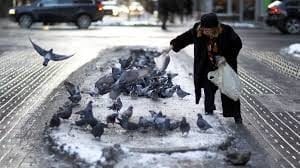
by Pigeon Patrol | Dec 17, 2019 | Bird Netting, Bird Spike, Bird Spikes, Pigeon Control, Pigeon Droppings, Pigeon Patrol's Services, Pigeon Spikes
A Manx bird charity has spoken against Douglas Council’s move to ban mass feeding of wild birds throughout the town.
Manx Wild Bird Aid (MWBA) is calling for the council to follow guidance set out by the Department of Environment, Food and Agriculture (DEFA) on how to manage the pigeon population without leaving them to starve.It also raises concerns about home bird feeders being affected.The council is now seeking approval from Tynwald to amend the Douglas General Byelaws 2013, in particular bylaw 19, which relates to ’feeding of animals and birds’.It wants to extend the current prohibited feeding zone to cover the entire Borough of Douglas.
 The current zone includes; Douglas seafront from the Bottleneck to the war memorial; Mona Terrace; Finch Road; Athol Street; Bridge Road; South Quay and Parade Street; plus areas on Prospect Terrace and Buck’s Road.Those caught flouting the bylaw would be given a fixed penalty notice.David Cole, a founding member of MWBA with his wife Barbara, doesn’t believe the bylaw would protect those who feed birds at home from being fined if a complaint is made against them.He said: ’The trouble is that Douglas Council says the bylaw doesn’t apply to people with bird tables in their gardens. A byelaw doesn’t have any exceptions.’In theory if someone says “the birds in your garden are annoying me” the bird feeder could be liable for a spot fine.’
The current zone includes; Douglas seafront from the Bottleneck to the war memorial; Mona Terrace; Finch Road; Athol Street; Bridge Road; South Quay and Parade Street; plus areas on Prospect Terrace and Buck’s Road.Those caught flouting the bylaw would be given a fixed penalty notice.David Cole, a founding member of MWBA with his wife Barbara, doesn’t believe the bylaw would protect those who feed birds at home from being fined if a complaint is made against them.He said: ’The trouble is that Douglas Council says the bylaw doesn’t apply to people with bird tables in their gardens. A byelaw doesn’t have any exceptions.’In theory if someone says “the birds in your garden are annoying me” the bird feeder could be liable for a spot fine.’
Council leader David Christian said: ’The changes the council is proposing are not about targeting well-meaning householders who have bird tables or garden feeders in their gardens. This we applaud.
’It’s about putting enforcement measures in place to deal with irresponsible individuals who persistently mass-feed birds, especially seagulls.’This is a practice which attracts large concentrations of birds, causes widespread public nuisance and distress and encourages vermin.’It also places undue demands on the council’s street cleansing operations and compromises our efforts to project a positive image for Douglas.’Advice given by the DEFA to local authorities includes having designated feeding areas set up for members of the public to freely feed pigeons and other birds.
In the document ’Advice and Information on Pigeon Control’, it also suggests setting up artificial breeding facilities, which has been said to decrease pigeon populations by as much as 50%.This is achieved by removing eggs that have been laid inside the nesting boxes and replacing them with dummy eggs.We previously reported in May about the worrying decline of seabird populations across the island.A survey was carried out over two years by Manx BirdLife with its 2017-18 census revealing that eight seabird species have suffered significant declines, with population losses of up to 82%.hen asked about this, Mr Cole said: ’We have got to give gulls a helping hand, particularly when it’s cold or during breeding season. When we take away that option [of being fed] it’s going to have an affect on a number of birds.’
He added: ’We deal with sick and injured birds. If there’s a sudden stop in the feeding of birds then a lot of them are going to starve because of it. There’s a lot of distressed birds in the island already.’’Milly would be here’ had Glasgow hospital followed adviceA mother whose daughter died at Scotland’s largest hospital has said her daughter would be still alive had concerns about water contamination risks been addressed in time.Kimberly Darroch was speaking after a leaked inspection report into Glasgow’s Queen Elizabeth University Hospital (QEUH) revealed “high risks” in 2015.
Milly Main, 10, contracted an infection in 2017 while on the hospital campus.She was recovering from leukaemia at the Royal Hospital for Children.
The QEUH 2015 inspection report, which ranked infection control measures as “high risk” in several areas just two days after the hospital opened, was passed to Labour MSP Anas Sarwar by whistleblowers. NHS Greater Glasgow and Clyde (NHSGGC) insisted the hospital campus had a “safe and effective water supply” and all inspection reports had been acted upon.
Warning of ‘high risk’ to water supply at hospitalHospital infection spiked at time of child’s deathMs Darroch told BBC Scotland on Thursday night: “I’m shocked with the information that came out today. The fact that they’ve known since since 2015, it’s absolutely disgusting that nothing was done about it and no action was taken and the hospital was still opened.
“I believe Milly would still be here if action had been taken. I’ve no doubt in my mind that Milly would be sitting beside me, right now.”There is no words to describe that pain of knowing that if things had been different, that if things had been sorted with the water, she would still be here.”I think the health board needs to be held to account for the mistakes that they made.”
She added: “We wouldn’t have been made aware of any of this if it wasn’t for the whistleblower coming forward.”I think there will continue to be shocking revelations for the foreseeable future.”
Kimberly Darroch said the leaked report had “shocked” herA spokesperson said the Scottish government was “examining in detail” the separate material Mr Sarwar had highlighted.
They added: “We want to ensure that all families who have been affected can get the answers that they are clearly entitled to and the health secretary has given her personal assurance that she will ensure this happens.”We are committed to making sure that these matters are dealt with transparently and with clear accountability, which is one of the reasons the health secretary has instructed a public inquiry in these matters to be chaired by Lord Brodie.”Ms Darroch said she was “very angry” and felt the health board had swept the case “under the carpet”.
A hospital complaints manager had contacted her on Thursday but she had not received an apology, she said.
Milly, who had leukaemia, underwent a successful stem cell transplant in July 2017 and was making a good recovery when the following month her Hickman line, a catheter used to administer drugs, became infected. Milly went into toxic shock and died days later.
Her death certificate lists a Stenotrophomonas infection of the Hickman line among the possible causes of death but Ms Darroch says the family were kept in the dark about a potential link to contaminated water problems at the hospital.
A spokeswoman for NHS Greater Glasgow and Clyde said: “We are very sorry for the ongoing distress that has been caused to Ms Darroch and we want to provide parents with as much support as possible.”We are in contact with Ms Darroch and would like to meet her to answer her questions if she would be happy to do that.”
The Legionella assessment was carried out by private contractor DMA Water Treatment two days after the hospital openedIn the Scottish Parliament, Mr Sarwar said he had seen figures which suggested there were 50 cases of infections at the Royal Children’s Hospital – part of the £842m QEUH campus – between 2015 and 2018, and a further 15 unconfirmed cases so far this year.
ressed on the warnings at first minister’s questions, Nicola Sturgeon said she was determined to get the “answers parents deserve”.The documents seen by Mr Sarwar show that NHS Estates commissioned three separate independent reports into the water supply at the QEUH.
The first Legionella assessment, carried out by private contractor DMA Water Treatment on 29 April 2015 – two days after the hospital welcomed its first patients – categorised the management of the bacteria as “high risk” because there was “significant communication issues between the parties” responsible for managing the risk.
The problem of contaminated water is one of a number to beset the Queen Elizabeth University Hospital (QEUH) and the adjoining Royal Hospital for Children.
Last year, two cancer wards at the children’s hospital were shut because of concerns about infection, and children were moved to the QEUH instead. An inquiry by Health Protection Scotland later identified 23 potential water supply-linked infections during 2018.In January it emerged two patients at the QEUH had died after contracting an infection linked to pigeon droppings.
City to remove hundreds of tonnes of pigeon poop from Sid Buckwold BridgeSaskatoon has a pigeon poop problem. A heavy one.
Since it opened in 1966, a flock of around 1,500 pigeons has called the Senator Sid Buckwold Bridge home. Over the last five decades, the city estimates that 348 tonnes of pigeon droppings have accumulated in the crevices and cavities of the 183-metre bridge.
Now, as part of a two-year plan to rehabilitate the concrete river crossing, the city is preparing to spend around $800,000 on specialized contractors who will capture and euthanize the pigeons, then manually remove 53 years worth of their feces.The next step will be to ensure pigeons can’t return, because the feces adds significantly to the bridge’s dead load and the uric acid in the droppings can eat into concrete and rebar, according to the city’s general manager of transportation and construction.
The droppings weigh as much as 232 mid-sized cars — within the limits for which the bridge is rated, but a potential concern should nothing be done, Angela Gardiner said Friday in an interview. Large piles of pigeon droppings also have potential health implications.
“There’s no immediate concern about the integrity of the bridge; it’s just the long-term potential that it could cause over a number of years and decades,” she said, adding that there is no indication the uric acid has damaged the bridge’s structure.
The city expects the work to begin next week. The first phase — trapping and euthanizing the birds — is slated to last about six weeks, while the “labour-intensive” cleaning is likely to continue through the summer and into the fall, Gardiner said.
Once the bridge is clean, the city plans to install barriers to ensure pigeons can’t return to the cavities and utility conduit under the span. Gardiner acknowledged that it’s impossible to completely eliminate the pigeons, but said the city will do what it can to keep them away.
While the city plans to keep an eye on its other major pieces of infrastructure, the Buckwold Bridge is thought to be particularly hospitable for pigeons. The city’s other bridges offer the birds far fewer opportunities to nest.
Pigeons are well-known pests that damage private property as well as municipal infrastructure. They are also thought to be among the most destructive; few other species are capable of causing as much damage.
“This job comes with a lot of new and unique things. Each project is different. We were aware there were pigeons (and) an issue with this bridge. But the extent of it is a lot bigger than I thought anyone anticipated,” Gardiner said.amacpherson@postmedia.com
About Pigeon Patrol:
Pigeon Patrol Products & Services is the leading manufacturer and distributor of bird deterrent (control) products in Canada. Pigeon Patrol products have solved pest bird problems in industrial, commercial, and residential settings since 2000, by using safe and humane bird deterrents with only bird and animal friendly solutions. At Pigeon Patrol, we manufacture and offer a variety of bird deterrents, ranging from Ultra-flex Bird Spikes with UV protection, Bird Netting, 4-S Gel and the best Ultrasonic and audible sound devices on the market today.
Contact us at 1- 877– 4– NO-BIRD, (604) 585-9279 or visit our website at www.pigeonpatrol.ca
Bird Gone, Pigeon Gone, Seagull Gone, Pigeon problems, pigeon spikes, 1-877-4NO-BIRD, 4-S Gel, Bird Control, Pigeon Control, bird repellent, Bird Spikes, sonic bird repellent, stainless steel bird spikes, bird spikes Vancouver, Ultra Sonic Bird Control, Bird Netting, Plastic Bird Spikes, Canada bird spike deterrents, Pigeon Pests, B Gone Pigeon, Pigeon Patrol, pest controller, pest control operator, pest control technician, Pigeon Control Products, humane pigeon spikes, pigeon deterrents, pigeon traps, Pigeon repellents, Sound & Laser Deterrents, wildlife control, raccoon, skunk, squirrel deterrent, De-Fence Spikes, Dragons Den, Canada bird spikes, Canada pigeon, pigeon control, pidgon patrol, pidgon. Kill pigeons, crow, starling
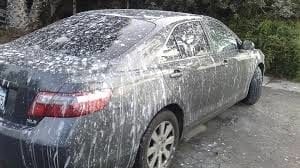
by Pigeon Patrol | Dec 17, 2019 | 4-S Gel Bird repellent, Animal Deterrent Products, Bird Deterrent Products, Bird Netting, Bird Spike, Pigeon Spikes, Pigeons in the News
 The Pigeon Poop Station Saga: Bird Pooping On Lawmaker’s Head Seems To Catch Local Leaders’ Attention
The Pigeon Poop Station Saga: Bird Pooping On Lawmaker’s Head Seems To Catch Local Leaders’ Attention
HICAGO (CBS) — The CBS 2 Morning Insiders got the scoop on the poop heard ’round the world.
Our video showed a pigeon relieving itself on an Illinois lawmaker as he talked about a problem at the Irving Park Blue Line station. It got international attention, but more importantly, it seems to have caught the eye of leaders locally.
CBS 2’s Lauren Victory met back up with Illinois state Rep. Jaime Andrade (D-Chicago) for this latest report. This time, they shot their interview strategically, given that a pigeon pooped on Andrade’s head as they spoke last time.
RELATED: State Rep. Searches For Funds To Clean Up Irving Park ‘Pigeon Poop Station,’ Gets Pooped On During Interview | ‘It Stinks To High Heaven’: No Solution In Sight For Pigeon Poop Problem At Irving Park Blue Line Stop
Victory: “Did you ever think that a pigeon would get you name recognition?”
Andrade: “Not that much. Not at this level.”
At the Kennedy Expressway underpass at Irving Park Road, where the entrance to the Blue Line station is located, the pigeons’ waste, feathers, and filth create a gross hopscotch game for commuters.
Last time, of course, Andrade couldn’t dodge said pigeons. The pigeon pooping video clip made headlines across the city, the country, and even the ocean.
“Farthest place I’ve heard so far is Spain,” Andrade said.
His feces fame is not for naught. Andrade said he spotted men in yellow vests hard at work after our most recent story aired.
“They said they were out here taking measurements from one of the agencies,” Andrade said. “I’ve been trying to get a real cost, price for over a year. You do the story and they’re out here, measurements just within a few days?”
The Chicago Transit Authority said it sent Landmark Pest Management crews to remove garbage from pigeon netting. As to whether they are working on something long-term, the CTA refused to say.
So Victory decided to learn more about Landmark. Its parent company, ABC Humane Wildlife Control and Prevention, is hired by several departments in Chicago and at the state level.
Landmark President Rebecca Fyffe told Victory that a city contract prevents her from speaking specifically about plans for the Irving Park station. But she pointed CBS 2 to her company’s pigeon abatement work at the Lawrence Red Line station in 2010.
Today, that area is fairly clean by city standards.
CBS 2 is told that Ald. James Cappleman (46th) pushed for the project after several pigeon-related complaints. Cappleman’s spokesman said bird poop was also causing CTA equipment to degrade, so the CTA picked up the bill – to the tune of $150,000. When asked if that figure scared him, Andrade said it did not.
“No, no, I hope it’s that,” he said. But Andrade’s problem is that Irving Park comes with jurisdiction issues. The Blue Line station is CTA property, but other parts of the overpass belong to the Illinois Department of Transportation. “Our constituents don’t care. All they want is the situation solved,” Andrade said. “This story has brought attention all the way to the top, so that I know.”
We’ll wait, and so will the pigeons – who are so comfortable along the overpass that even a train won’t make them flinch.
If you have something you want the Morning Insiders to check out in your neighborhood, email cbschicagotips@cbs.com.
About Pigeon Patrol:
Pigeon Patrol Products & Services is the leading manufacturer and distributor of bird deterrent (control) products in Canada. Pigeon Patrol products have solved pest bird problems in industrial, commercial, and residential settings since 2000, by using safe and humane bird deterrents with only bird and animal friendly solutions. At Pigeon Patrol, we manufacture and offer a variety of bird deterrents, ranging from Ultra-flex Bird Spikes with UV protection, Bird Netting, 4-S Gel and the best Ultrasonic and audible sound devices on the market today.
Contact us at 1- 877– 4– NO-BIRD, (604) 585-9279 or visit our website at www.pigeonpatrol.ca
Bird Gone, Pigeon Gone, Seagull Gone, Pigeon problems, pigeon spikes, 1-877-4NO-BIRD, 4-S Gel, Bird Control, Pigeon Control, bird repellent, Bird Spikes, sonic bird repellent, stainless steel bird spikes, bird spikes Vancouver, Ultra Sonic Bird Control, Bird Netting, Plastic Bird Spikes, Canada bird spike deterrents, Pigeon Pests, B Gone Pigeon, Pigeon Patrol, pest controller, pest control operator, pest control technician, Pigeon Control Products, humane pigeon spikes, pigeon deterrents, pigeon traps, Pigeon repellents, Sound & Laser Deterrents, wildlife control, raccoon, skunk, squirrel deterrent, De-Fence Spikes, Dragons Den, Canada bird spikes, Canada pigeon, pigeon control, pidgon patrol, pidgon. Kill pigeons, crow, starling
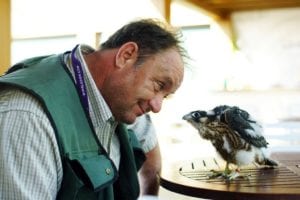
by Pigeon Patrol | Dec 17, 2019 | Bird Netting, Bird Spikes, Pigeon Control, Pigeon Droppings, Pigeon Spikes, Pigeons in the News, UltraSonic Bird Control
Fifteen-year-old Aurora Milbrandt impressed Saskatoon Mayor Charlie Clark with a presentation at city hall on how to deal with pesky pigeons in a humane way.
Milbrandt appeared at Monday’s meeting of city council’s environment, utilities and community services committee to address a request to ban the use of neurotoxins to kill nuisance pigeons.
“Wow,” Clark said after Milbrandt’s presentation. “For a Grade 10 student, that was a very well presented set of arguments and solutions.”
Milbrandt targeted the product Avitrol, saying contrary to what some believe the chemical agent can result in a “very painful death” for pigeons and other small animals that consume it.
She suggested the city consider euthanizing pigeons as a last resort and focus on other measures — educating the public not to feed pigeons, using a birth control product to make female pigeons barren and employing a predator like a hawk or falcon.
The committee heard that the City of Saskatoon no longer uses Avitrol. Clark asked whether any city has banned its use throughout the community, including by private citizens and businesses.
City lawyer Blair Bleakney told the committee the city could enact a bylaw to govern chemical use on private property, but advised against a ban on a specific product.
The committee voted unanimously to direct the administration to study a pest management strategy for the city.
The city contracts out pest management, including pigeon control, to private contractors and Avitrol has been used in the past, a city report says.
The city stopped using Avitrol after Jan Shaddick, executive director of Living Sky Wildlife Rehabilitation, appeared before the same committee in May to request the city discontinue the product’s use, the report adds.
The city hired a contractor this year to euthanize about 1,500 pigeons that had made their home inside cavities in the piers of the Senator Sidney L. Buckwold Bridge, the report notes. In September, the city said 2,300 pigeons were euthanized.
Angela Gardiner, the city’s general manager of utilities and environment, said there is an understanding between city hall and the contractor that animals will be euthanized according to Canadian Veterinary Medical Association (CVMA) standards.
“The CVMA holds that when animals are euthanized, death must be quick using a method that causes the least possible pain and distress,” Gardiner wrote in an email.
She did not know the exact method of euthanasia used for the Buckwold Bridge pigeons. Grating was installed during rehabilitation work on the bridge to ensure pigeons do not return to the cavities.
The company working on the bridge removed about 635 tonnes of pigeon waste from the cavities.
ptank@postmedia.com
About Pigeon Patrol:
Pigeon Patrol Products & Services is the leading manufacturer and distributor of bird deterrent (control) products in Canada. Pigeon Patrol products have solved pest bird problems in industrial, commercial, and residential settings since 2000, by using safe and humane bird deterrents with only bird and animal friendly solutions. At Pigeon Patrol, we manufacture and offer a variety of bird deterrents, ranging from Ultra-flex Bird Spikes with UV protection, Bird Netting, 4-S Gel and the best Ultrasonic and audible sound devices on the market today.
Contact us at 1- 877– 4– NO-BIRD, (604) 585-9279 or visit our website at www.pigeonpatrol.ca
Bird Gone, Pigeon Gone, Seagull Gone, Pigeon problems, pigeon spikes, 1-877-4NO-BIRD, 4-S Gel, Bird Control, Pigeon Control, bird repellent, Bird Spikes, sonic bird repellent, stainless steel bird spikes, bird spikes Vancouver, Ultra Sonic Bird Control, Bird Netting, Plastic Bird Spikes, Canada bird spike deterrents, Pigeon Pests, B Gone Pigeon, Pigeon Patrol, pest controller, pest control operator, pest control technician, Pigeon Control Products, humane pigeon spikes, pigeon deterrents, pigeon traps, Pigeon repellents, Sound & Laser Deterrents, wildlife control, raccoon, skunk, squirrel deterrent, De-Fence Spikes, Dragons Den, Canada bird spikes, Canada pigeon, pigeon control, pidgon patrol, pidgon. Kill pigeons, crow, starling
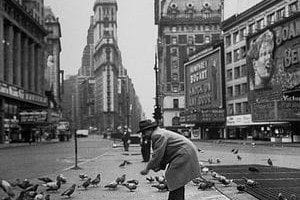
by Pigeon Patrol | Oct 17, 2019 | 4-S Gel Bird repellent, Animal Deterrent Products, Bird Netting, Bird Spikes, Pigeon Control, Pigeon Droppings, Pigeon Patrol's Services, Pigeon Spikes

The new pigeon wars
By Sheila McClear – NY POST
Rats with wings, or majestic streetwise bird? It’s a debate that’s raged almost as long as New York City has been called that. And this week, the war between the two sides boiled over again.
It started when the exclusive University Club had its feathers ruffled. It wanted to drape its storied building in netting, to protect it from pigeon poo, which eats away at stone and metal.
But the Landmarks Commission said it would have to wait for approval, as it would be a “visible change” to the landmarked Italian Renaissance building’s façade. As if the crap wasn’t a “visible change” enough.
Meanwhile, over on East 93rd Street, there was a scuffle involving longtime pigeon activist Anna Dove and her neighbor, who snatched away her bag of seed after he saw her feeding the pigeons on the sidewalk. The police were summoned.
“It’s disgusting,” said her nemesis, retired teacher Arthur Schwartz. “She’s feeding the rats.”
And with the live pigeon-shooting state championships in Pennsylvania coming up, it’s almost guaranteed that there will be an increase in demand of pigeon-poaching — New York City is a favorite spot for trapping them and transporting them to be used as live targets. The animal-rights activists will be out with their cameras and signs to stop them.
No matter which side you’re on, one things for certain — by the end, things are going to get a little birdbrained.
“It’s not the pigeons that are the problem, it’s the number of them,” says Andrew D. Blechman, author of “Pigeons: The Fascinating Saga of the World’s Most Revered and Reviled Bird.” “They’re gentle creatures. The problem is that they get in our face, just like we get in each other’s faces.”
No one one’s quite sure of how many pigeons are in New York City. One adage is “one pigeon per person,” which would put their numbers at about 7 million. They each produce about 25 pounds of waste per year.
Pigeons love cities because of the many ledges, windowsills, eaves and rooftops available for them to roost in, which mimics their natural habitat of high cliffs. Pigeon pairings are monogamous, often mating for life, and both parents raise the babies — called squab — for a time, sitting on the eggs in shifts.
The pigeon includes about 298 species of bird, but the Rock Dove is the most common to the New York area, according to the Parks Department. The grey, bobbing-headed birds usually have purple-green iridescence around the neck area. They’re the scruffiest members of the dove family — although “dove” usually connotes the pure white symbols of peace, not the pizza scavengers of city streets. (Just say they’ve been pigeonholed.)
“If they were white,” Blechman says, “people would love them.”
Blame the French for our pigeon problems. The little pluckers first arrived in the early 1600s with French settlers who used them for meat. They were easy to raise — they could be kept in a barn, where they’d perch on the rafters, and young pigeons served as a good source of protein.
But they soon escaped their confines and went feral.
City life agreed with them and allowed them to flourish — and in some cases, over-flourish. Their natural predators, like falcons and hawks, aren’t found here in great numbers.
Courtney Humphries, author of “Superdove: How the Pigeon Took Manhattan . . . And the World,” concedes that pigeon are pilloried partly because of their “persistence. They nest on the buildings we consider our territory, and they don’t like to be moved.”
The average city pigeon has a lifespan of three to five years. With all the food scattered throughout the garbage cans and sidewalks — plus well-meaning human feeders — they spend less time looking for grub, which leaves more time for mating.
“The biggest problem is the people who overfeed them,” says Blechman. “Every city has about a dozen of them, and they’re the ones who cause the [overpopulation] problem.”
He suggests that if you want to feed the birds, hand out just a teaspoon full of birdseed for a flock. “It’s just enough to give them a little extra energy while they’re out trying to find their own food.”
“If nobody fed pigeons, I think things would look a lot different,” agrees Humphries, who says that human feeders end up creating dense flocks. “A lot of the problem with pigeons comes from people.”
If you can’t freeze the hearts of little old ladies, though, you could try eating them (the pigeons, that is). Squab — baby pigeons that haven’t flown yet — is on the menu at many restaurants around the city, particularly French. They’re “basically the milk-fed veal of the sky,” says Blechman — tender, mostly dark meat, and one of the only poultry that can be eaten rare. (Pigeons produce their own milk-like substance, which they feed to their young by regurgitation.)
Pigeon pot pie was a huge colonial favorite. Today, try the Squab and Foie Croustillant at the Modern, Danny Meyer’s restaurant at the Museum of Modern Art.
*
Unless the appetite for squab skyrockets, New York’s options are few. Avicide — poisoning birds — was made illegal in 2000, when the state Legislature passed a bill outlawing the use of “flock dispersal agents” like Avitrol in cities with more than 1 million people.
Before that, property managers regularly hired pest control services to dole out Avatrol to flocks of pigeons.
“In theory, you would mix it with feed, and when one pigeon ate some of the treated food, they would begin to suffer from neurological toxicity,” explained Stephanie Boyles, wildlife expert at the Humane Society of the United States. “When their flockmates saw them suffering, it would prompt them to leave the area.”
In practice, however, overdosing often led to large numbers of birds convulsing and writhing in pain on the street before their deaths. Welcome to New York!
The last major flare-up between pigeons and people was in 2007, when City Councilman Simcha Felder released a report plaintively titled, “Curbing the Pigeon Conundrum.”
Claiming that their droppings carried a host of diseases like histoplasmosis, he proposed a $1,000 fine to anyone feeding them, as well as curbing their numbers through birth control (a measure that cities like Los Angeles have adopted, although some argue that it’s unsustainable), and appointing a city “Pigeon Czar” to oversee other pigeon-control issues.
The NYC Department of of Health and Mental Hygiene maintains that contact with their droppings only poses a small health risk, and that “routine cleaning of droppings (e.g. from windowsills) does not pose a serious health risk to most people,” although disposable gloves are a good idea.
The Humane Society came out against the anti-feeding fine because they weren’t sure it would actually make a difference in reducing flocks, said Boyles. “We still suggest working with communities to create places where pigeons are welcome, and discouraging them where they’re not.”
While Felder’s bill didn’t fly, it was only one of many efforts to keep pigeons clipped.
In 2006, pigeon loitering was so dense near the Army Recruitment Center in Times Square, speakers were set up to broadcast sounds of falcons and pigeons being attacked, in hopes of scaring them away. In 2003, they had so overwhelmed Bryant Park that the operators invited a falconer and his hawk to the park for a week to scare away (not eat) the pigeons.
In 2007, the MTA installed Bird-B-Gone on some of its elevated stations along the 7 line, as well as others. The electronic system zapped birds that got too close.
In the ’80s, plastic owls were a big seller. Today, a slightly more high-tech version, called the RoboHawk, moves its head, wings, and makes what its creators hope are pigeon-threatening sounds.
Every so often, a politician considers reviving an overall anti-feeding bill, since, for now, it’s only illegal in city parks where signs are posted (the fine is usually $50).
Some cling to the hope that the city will come to its senses and declare war. Because they’re a non-native species, pigeons are not protected by either the Federal Migratory Birds Act or New York state laws. Can anyone say hunting season?
It’s got to be done mafia-style, though. Culling is only a temporary solution — as with most wild birds, quick breeding will put their numbers back to pre-cull figures within weeks, according to Pigeon Control Advisory Service.
*
But spare a thought, pigeon haters, for your majestic foe. Pigeons have more qualities than you think.
Although city birds aren’t particularly active, pigeons are built to be athletes — a trained bird can fly up to 60 miles per hour, and they can stay in the air for 500 miles. They’re meant for flying long distances, and have “homing” instincts, which means they will naturally find their way back.
This talent is why they were literally drafted into the United States Army Pigeon Service.
A million served in both world wars, where they delivered messages across enemy lines and saved thousands of soldiers’ lives. One pigeon, Cher Ami, won a French medal for his bravery for flying through gunfire, finally delivering the message dangling from what was left of his foot. He’s now stuffed and in the Smithsonian.
The army’s Pigeon Breeding and Training Center was based at Fort Monmouth, NJ, and opened in 1917. Many of its “Pigeoneers” were “basically just boys out of Brooklyn, and they’d just bring their best birds,” Humphries says. (The training center was closed in 1957 when the Army stopped using them as messengers.)
Keeping pigeons on rooftops — and racing them — used to be much more popular. Who can forget Marlon Brando’s character in the 1954 film “On the Waterfront” shouting up to his friend Joey, “I got one of your birds!” right before Joey “accidentally” falls off the roof?
The city is full of equally vocal bird-lovers.
“They animate our lives,” argues Blechman, who says that despite writing a book on pigeons, he is not a “bird person,” and admits to having eaten them before. He’s come around, though. “You look out the window and you can have a pigeon land on your windowsill, and the same one will come back every day, and at the same time.
“What would the lonely, the unemployed, and the elderly do every day if it weren’t for pigeons?”
The Internet is atwitter with kooky pigeon fans. There’s a pigeon appreciation society on Facebook. On photo-sharing site Flickr, there’s a group called The Global Pigeon Art Appreciation Society.
“You are not alone,” the site reads. “Many artists have been inspired by pigeons.”
There is also a city listserv called “New York Pigeon People,” where members discuss how to rescue birds and share pigeon news.
You can eat them, race them, breed them, feed them, but you can’t escape them, whether you consider them the most misunderstood creatures of the flying community or the world’s worst bird. As Blechman put it, “We’re just going to have to learn to co-exist.”
About Pigeon Patrol:
Pigeon Patrol Products & Services is the leading manufacturer and distributor of bird deterrent (control) products in Canada. Pigeon Patrol products have solved pest bird problems in industrial, commercial, and residential settings since 2000, by using safe and humane bird deterrents with only bird and animal friendly solutions. At Pigeon Patrol, we manufacture and offer a variety of bird deterrents, ranging from Ultra-flex Bird Spikes with UV protection, Bird Netting, 4-S Gel and the best Ultrasonic and audible sound devices on the market today.
Contact us at 1- 877– 4– NO-BIRD, (604) 585-9279 or visit our website at www.pigeonpatrol.ca

by Pigeon Patrol | Sep 17, 2019 | 4-S Gel Bird repellent, Animal Deterrent Products, Bird Deterrent Products, Bird Netting, Bird Spikes, Pigeon Control, Pigeon Droppings, Pigeon Patrol's Services

Cadiz Cathedral in Spain is facing a pigeon infestation.
Laura Perez Maestro, CNN • Updated 13th December 2018
(CNN) — It’s always nice to share a meal with the locals on vacation, except when the locals steal your food, smash your plate, defecate on the table — and then fly away. Cadiz has been facing this exact pigeon problem.
That’s the situation in the southwestern Spanish port town of Cádiz where pigeons have been terrorizing tourists to such an extent that local authorities are now taking steps to banish thousands of birds.
“We are not exaggerating, the pigeons are not scared of humans any more,” Carlos Fernández, the manager of one of the restaurants in Cádiz’s beautiful Cathedral Square, tells CNN.
“They throw themselves at the food even when there are clients seating ready to eat it. They push glasses, plates and jars on to the floor and it’s a real mess.”
And when tourists give up on Cádiz’s sunny terraces and move inside, there’s still no escape from the birds, Fernández says.
“Even inside the restaurant, they come in, they know where the food is and that we don’t do anything to them, they are not scared”, adds Fernández.
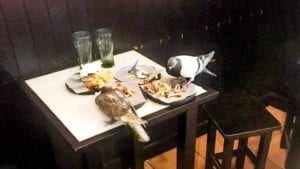
Brazen Pigeons feeding directly from the table.
He says that the population of pigeons is now so high that customers pestered by the pigeons are being scarred by their experiences. “They don’t come back.”
It’s not a pretty picture either. The square’s winged residents “decorate” building facades and restaurant tables and chairs. They even make the ground difficult to walk on, says Fernández.
After a pigeon census by the city council decreed that the bird population of 9,000 was three times as many as Cádiz could sustain, authorities decided to take steps.
The plan is to catch and relocate 5,000 pigeons over a period of a year instead of culling them. They’ll then be transported at least 170 miles away — a distance hoped to discourage them from returning.
Alvaro de la Fuente, of the council’s environmental department, says the city wants “a respectful and sustainable solution to reduce the impact of the birds on cities like Cádiz.”
He adds that by relocating rather than exterminating the birds, Cádiz hopes to “establish a logical equilibrium where the cohabitation between humans and birds doesn’t damage either.”
The local government is confident this project will work because, although pigeons have strong homing instincts, once you take them beyond 170 miles from their home they tend to stay and settle in their new surroundings.
Some 3,000 leaflets instructing people to stop feeding the birds are also being distributed to make the change a little bit easier.
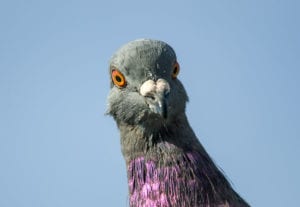
Health risks
Cádiz’s hoteliers, who say they’ve lost 20% of their business because of the pigeons and warned of health risks to their employees, welcome the relocation plan but want it implemented ASAP.
“It’s been years since we brought up the problem and started talking with the city hall,” says Antonio de María, president of Cádiz hoteliers association, Horeca.
“A few months ago, we were presented with a plan to move the pigeons to another city but they now say they need a health assessment on the pigeons that will be moved, so the project keeps getting delayed.”
Cádiz is not the only city with bird problems. In November, Rome’s authorities began using falcons to drive thousands of starlings out of the ancient city.

 The current zone includes; Douglas seafront from the Bottleneck to the war memorial; Mona Terrace; Finch Road; Athol Street; Bridge Road; South Quay and Parade Street; plus areas on Prospect Terrace and Buck’s Road.Those caught flouting the bylaw would be given a fixed penalty notice.David Cole, a founding member of MWBA with his wife Barbara, doesn’t believe the bylaw would protect those who feed birds at home from being fined if a complaint is made against them.He said: ’The trouble is that Douglas Council says the bylaw doesn’t apply to people with bird tables in their gardens. A byelaw doesn’t have any exceptions.’In theory if someone says “the birds in your garden are annoying me” the bird feeder could be liable for a spot fine.’
The current zone includes; Douglas seafront from the Bottleneck to the war memorial; Mona Terrace; Finch Road; Athol Street; Bridge Road; South Quay and Parade Street; plus areas on Prospect Terrace and Buck’s Road.Those caught flouting the bylaw would be given a fixed penalty notice.David Cole, a founding member of MWBA with his wife Barbara, doesn’t believe the bylaw would protect those who feed birds at home from being fined if a complaint is made against them.He said: ’The trouble is that Douglas Council says the bylaw doesn’t apply to people with bird tables in their gardens. A byelaw doesn’t have any exceptions.’In theory if someone says “the birds in your garden are annoying me” the bird feeder could be liable for a spot fine.’






